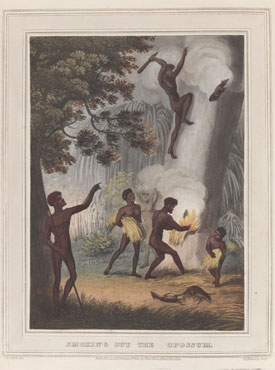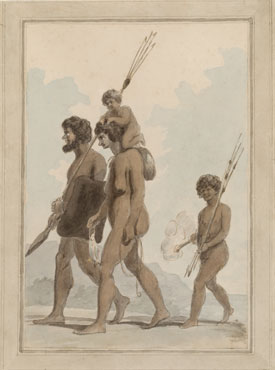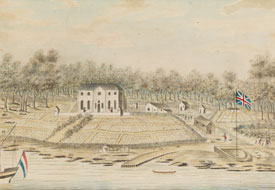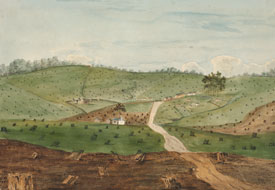Life on the land
Living and working on the land has been part of the popular image of Australia since the earliest days of settlement. Colonisation of Australia saw a transformation of the natural landscape of our continent though agriculture.
For thousands of years before the first Europeans arrived, Indigenous Australians had been living on and manipulating the land and the environment. Indigenous Australian methods of agriculture, horticulture and aquaculture included crop-growing, fish-trapping and controlled burning (‘fire-stick farming’) to encourage new growth in native plants and to facilitate hunting.
Regularly burning off vegetation had the long term effect of turning scrub into grassland directly increasing the food supply of the aborigines by changing the composition of plant and animal species in an area. It also promoted growth of edible ground level plants, such as bush potatoes, and boosted the population of grass-eating species like the kangaroo.
 'Smoking out the Opossum'
'Smoking out the Opossum'Handcoloured engraving. Foreign field
sports, fisheries and sporting anecdotes...,
1814, London. DSM/Q799/1A1
Governor Phillip quickly realized that the land around Farm Cove would not support the colony. The search for suitable land for agriculture led to the discovery of arable plains fed by the waters of the Parramatta River, which Phillip named Rose Hill. By late 1791, agriculture had been abandoned at Farm Cove and all efforts were concentrated on the spread of cultivation at Rose Hill, now called Parramatta. The success of these farms was crucial to the food obsessed colony and Governor Phillip rewarded early agriculturalists, like James Ruse, with grants of land.
> Find out more about early land grants and Australia's first farmers
When the British settled Australia, the colonial government claimed all lands for the Crown. Successive governors of New South Wales had exclusive authority to make land grants. In 1824 an Act of British Parliament established the Australian Agricultural Company (AACo.) which was set up on one million acres at Port Stephens, NSW, to improve production of fine wool and other crops for export.
> Find out more about the Australian Agricultural Company
From the 1820s, however, the occupation of Crown land without legal title became a widespread practice in the colony. Such landholders, who took up residence on large unoccupied tracts of land for pastoral purposes, were known as 'squatters'.
> Find out more about the role of squatters in colonial agriculture
In isolated rural districts pastoral properties, or stations, were centres of activity & hospitality which often belied the constant struggle for self-sufficiency and the loneliness of station life.
Life on the land could afford wealthy pastoralists with an elegant lifestyle and plenty of time for rural leisure pursuits outside hectic breeding, sowing, shearing and harvesting seasons.
>Find out more about life on sheep and cattle stations in colonial Australia
The advance of settlement saw a swift transformation from the natural to the cultivated landscape. Post and rail fences kept the bush at bay while verandahed homesteads surrounded by carefully manicured lawns and gardens created a picturesque contrast between the wilderness of spreading plains and dramatic mountain backdrops.
> Find out more about the lifestyle on colonial homesteads







